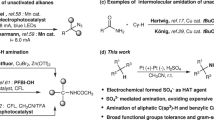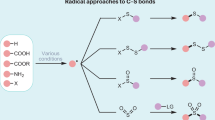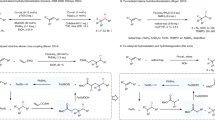Abstract
A controlled new oxidant sulfate radical anion (SO4.–) was found and it can be easily prepared by mixing Na2S2O4 and TBHP with stirring. In this new metal-free oxidation system (Na2S2O4/TBHP), SO4.– can be used as a controllable oxidant to oxidize various aromatic alcohols to the corresponding aldehydes in good yields without any acid formation at room temperature. SO4.– was determined by a DMPO (5,5-dimethyl-1-pyrroline-N-oxide) spin-trapping EPR method at room temperature on a Bruker E500 spectrometer and the results suggested that SO4.– was generated in this transformation.
Similar content being viewed by others
Introduction
The selective oxidation of alcohols to the corresponding aldehydes is highly relevant reactions in organic chemistry1,2 and is a fundamental and pivotal transformation for laboratory research and industrial manufacturing3. To date, great efforts have been continuously devoted to the development of excellent oxidation systems for alcohol oxidations4,5,6. Classically, oxidations of alcohols are performed with inorganic oxidants (notably chromium and manganese oxides), Swern reagents and Dess-Martin reagents (Fig. 1)7,8. However, these stoichiometric oxidants suffer from many drawbacks such as relatively expensive reagents and difficulties in handling heavy-metal wastes9. From the viewpoints of environmental concern, more and more attention has been paid towards the development of catalytic aerobic alcohol oxidation methodologies10,11. In the past few decades, transition metal-catalyzed oxidation of alcohols to aldehydes or ketones has been established12,13. For example, the catalytic systems employing different transition metals in combination with TEMPO (2,2,6,6-tetramethyl-piperidyl-1-oxy) or TBHP (tert-butyl hydroperoxide)14,15. Although many of these methods were effective for the preparation of the desired products, additional base, transition metals and high reaction temperatures are often needed as shown in Fig. 19.
Recently, a transition-metal-free catalytic system for oxidations catalyzed by TEMPO/NaNO2 has attracted special attention due to their outstanding catalytic efficiency16,17. However, these methods have some drawbacks, such as the use of O2 often requires work in autoclaves18. And high reaction temperatures are often needed. Despite lots of precedents and advancements in alcohol oxidation strategies recently, there have been few reports on the metal-free oxidation system for oxidation catalyzed by TBHP under mild conditions. Thus, the search for developing highly efficient oxidation system without metals for the oxidation of alcohols remains an area of intensive interest.
As we all know, Na2S2O4 (sodium dithionite) is one of the most widely used strong reducing agents in organic chemistry. For example, in the synthesis of the chiral NADH models, Na2S2O4 is often used as the most effective reducing agent19,20,21. Na2S2O4 is an effective reagent for the reduction of aldehydes and ketones to the corresponding alcohols22. As a continuation of our research on TBHP and Na2S2O419,20,21,23, in a accidental opportunity, we found that TBHP/Na2S2O4 can oxidize aromatic alcohols to corresponding aldehydes without any acid formation.
Furthermore, sulfate radical anion (SO4.–) can be formed by thermal activation, UV photolysis and transition metal catalysis24,25,26,27,28. In this paper, a controlled new oxidant sulfate radical anion (SO4.–) was found and it can be easily prepared by mixing Na2S2O4 and TBHP with stirring. To the best of our knowledge, this is first report that sulfate radical anion can be used as controllable oxidant to oxidize various aromatic alcohols to the corresponding aldehydes in good yields without any acid formation.
Results and Discussion
We initially investigated the reaction between 4-methoxybenzyl alcohol (1a) with Na2S2O4 in the presence of 1 equiv of TBHP in EtOAc at room temperature for 12 h (Table 1, entry 1). To our delight, the Na2S2O4/TBHP oxidation system showed good catalytic activity for oxidation of 1a to p-anisaldehyde (2a) with a good yield of 60% at room temperature (entry 1). Having a promising result in hand, we then optimized the reaction conditions. The initial study was carried out using 4-methoxybenzyl alcohol (1a) as the model substrate. The results were summarized in Table 1. It was found that the reactivity of the oxidation reaction was the best when molar ratio of Na2S2O4/TBHP/substrate was 2:4:1 (entry 4), while decreasing of the ratio led to lower reactivity (entry 1–3). Increasing the amount of aqueous TBHP or using anhydrous TBHP did not improve the yield of compound 2a, only 81% and 78%, respectively (entries 4 and 5). Further blank experiments confirmed that the substrates were unreactive in the absence of either TBHP or Na2S2O4 (entries 6 and 7). The fact indicated that both TBHP and Na2S2O4 were essential for the oxidation. When other different oxidizing agents were used, such as NBS, BPO and DTBP, the yields were not high enough compared with the usage of TBHP (entries 9–11). In addition, no oxidation product was produced when H2O2 was used under this condition (entry 8). A profound solvent effect on the reactions was observed (entries 12–16). When the reaction was carried out in various solvents such as CH3CN, CH2Cl2, CHCl3, THF, cyclohexane and EtOAc, the best yield was observed using EtOAc. Hence, EtOAc was considered as an optimal solvent.
To probe the efficiency of the Na2S2O4/TBHP oxidation system, the oxidation of various aromatic alcohols to the corresponding aldehydes was studied under the optimized conditions as summarized in Fig. 2. By the comparison of spectral data (1H and 13C NMR) with the authentic samples, all the aldehydes were well characterized. Benzylic alcohols with electron-donating substituents (e.g., methoxy) can be oxidized into corresponding aldehydes in excellent yields. However, in case of nitro-substituted benzylic alcohols, the yield was comparatively less than that of the electron-donating counterparts (2h). Under the same conditions, for aromatic alcohols with methoxy-substituted (2a–2c) and nitro-substituted (2h–2j) benzene ring, para-, ortho- and meta- aromatic alcohols could be converted into the corresponding products with good yields, respectively. Aromatic alcohols substituted with halogen gave satisfactory yields under the optimized conditions (2f and 2g). Some other aromatic substrates such as furfurol and 2-thiophene methanol were readily oxidized to furfural and 2-thiophenecarboxaldehyde, respectively (2m, 2n). However, only trace oxidation product was obtained with pyridin-2-ylmethanol (2o). In addition, we conducted a large-scale (10 mmol) reaction and the results showed that this new oxidation system was also very effective even on the gram scale (2ab). In fact, we have previously studied some substrates with 2° aromatic alcohols. We found that the desired product acetophenone can be obtained in 53% yield. Unfortunately, this system is not good for controllable oxidation of fatty alcohols to their corresponding aldehydes.
The reaction was performed in the presence of Na2S2O4/TBHP under N2 atmosphere (Fig. 3) and the results showed that TBHP as the terminal oxidant in this reaction. Furthermore, the reaction yield dropped when radical inhibitor BHT (butylated hydroxytoluene) and TEMPO (2,2,6,6-tetramethylpiperidin-1-yloxyl) was added, respectively (Fig. 3). It indicated that the reaction should undergo a radical process. EPR spin trapping using the commonly used spin trap, 5,5-dimethyl-1-pyrroline-N-oxide (DMPO), has been employed in the detection of SO4.– (see Supplementary Figs S1 and S2 online). A quartet of signals were detected during the reaction process and the results suggested that SO4.– was generated in this transformation29. As shown in Fig. S1 and Fig. S2, with the prolonged reaction time, the concentration of SO4.– was also gradually increasing in ethyl acetate or acetonitrile.
In fact, we have used sodium sulfate (Na2SO4) in place of dithionate (Na2S2O4) to drive the reaction and further prolonged the reaction time, but no reaction was observed (Fig. 3). In this reaction, nascent state SO42− should be an activated species, which generated and consumed to form SO4.– very quickly in the reaction. Furthermore, we have considered the formation of persulfate (S2O82−) from sulfate by TBHP (Fig. 3). We also tried to test the intermediate reaction by mixing K2S2O8 and TBHP under the optimized conditions. However, we found that the desired product 2a could not be obtained. The result shows that SO4.– can not be generated from S2O82− under this conditions. Besides, we tested the mass spectra. A signal at m/z = 96.9600 was observed (see Supplementary online). That was assigned to [SO42−+H]− (calculated: 96.9596) species. The results suggested that SO42− was only generated in the process of forming product.
On the basis of previous studies and the results of our experiments30,31, a plausible reaction mechanism of the oxidation of aromatic alcohols to aldehydes is proposed. A radical anion A (sulfate radical anion) could be generated by action of TBHP and Na2S2O4 in this reaction. A was found to be an excellent controllable oxidant for oxidation of aromatic alcohols B to aldehydes C under this reaction conditions.
Conclusion
In conclusion, we have developed a new metal-free oxidation system, which was applied to oxidize various primary aromatic alcohols to corresponding aldehydes in good yields at room temperature. This is a new way to produce SO4.– by the new oxidation system. The present protocol provides a new tool for alcohol controllable oxidation under mild conditions and also could be used widely in general organic synthesis. Detailed mechanistic studies and other applications of the new oxidation system in organic reactions are under way in our laboratory.
Methods
Full experimental details and characterization of the compounds can be found in the Supplementary Information.
General. All solvents and chemicals are used directly from commercial sources without further purification. Analytical Thin Layer Chromatography was carried out on precoated plates (silica gel 60), visualized with UV light. NMR spectra was performed on a Bruker DPX-400 spectrometer operating at 400 MHz (1H NMR). All spectra were recorded in CDCl3 and the chemical shifts (δ) are reported in ppm relative to tetramethylsilane referenced to the residual solvent peaks. High-resolution mass spectral analyses (HRMS) were measured using ESI ionization. Sulfate radical anion were determined by a DMPO spin-trapping EPR method at room temperature on a Bruker E500 spectrometer. Instrument settings were modulation frequency: 100.00 KHz; modulation amplitude: 2.00 G; sweep width: 100.00 G; time constant: 40.960 ms; conversion: 40.000 ms; sweep time: 40.96 s. The microwave power was 10.03 mW and the frequency was 9.857 GHz.
General Procedure for the Synthesis of Products 2
To a mixture of alcohol (0.5 mmol) and Na2S2O4 (174 mg, 1.0 mmol) in ethyl acetate (4 mL) was slowly added tert-butyl hydroperoxide (257 mg, 2.0 mmol, 70% in water). The mixture was stirred at room temperature for 12 h. After evaporation of ethyl acetate under reduced pressure, the residue was separated on a silica gel column by using petroleum ether and ethyl acetate as eluent.
Additional Information
How to cite this article: Bai, C.-B. et al. An Unexpected Controlled New Oxidant: SO4.–. Sci. Rep. 6, 20163; doi: 10.1038/srep20163 (2016).
References
Shin, K. et al. Photoinduced oxidation of secondary alcohols using 4-benzoylpyridine as an oxidant. Org. Lett. 17, 3326–3329 (2015).
Doi, R. et al. Development of an azanoradamantane-type nitroxyl radical catalyst for class-selective oxidation of alcohols. J. Org. Chem. 80, 401–413 (2015).
Tang, L. et al. Pt, Pd and Au nanoparticles supported on a DNA–MMT hybrid: efficient catalysts for highly selective oxidation of primary alcohols to aldehydes, acids and esters. Chem. Commun. 49, 5213–5215 (2013).
Enache, D. I. et al. Solvent-Free oxidation of primary alcohols to aldehydes using Au-Pd/TiO2 catalysts. Science 311, 362–365 (2006).
Uyanik, M., Akakura, M. & Ishihara, K. 2-Iodoxybenzenesulfonic acid as an extremely active catalyst for the selective oxidation of alcohols to aldehydes, ketones, carboxylic acids and enones with oxone. J. Am. Chem. Soc. 131, 251–262 (2009).
Feng, X. et al. Aerobic oxidation of alcohols and the synthesis of benzoxazoles catalyzed by a cuprocupric coordination polymer (Cu+-CP) assisted by TEMPO. Inorg. Chem. 54, 2088–2090 (2015).
Corey, E. J. & Suggs, J. W. Pyridinium chlorochromate. An efficient reagent for oxidation of primary and secondary alcohols to carbonyl compounds. Tetrahedron Lett. 16, 2647–2650 (1975).
Taylor, R. J. K. et al. Tandem oxidation processes using manganese dioxide: discovery, applications and current studies. Acc. Chem. Res. 38, 851–869 (2005).
Liu, X.-L. et al. Cu-NHC-TEMPO catalyzed aerobic oxidation of primary alcohols to aldehydes. J. Org. Chem. 78, 8531–8536 (2013).
Xu, B., Lumb, J.-P. & Arndtsen, B. A. A TEMPO-free copper-catalyzed aerobic oxidation of alcohols. Angew. Chem. Int. Ed. 54, 4208–4211 (2015).
Chen, B.-T. et al. Enzyme-Inspired functional surfactant for aerobic oxidation of activated alcohols to aldehydes in water. ACS Catal. 5, 1313–1317 (2015).
Gartshore, C. J. & Lupton, D. W. Readily Accessible oxazolidine nitroxyl radicals: bifunctional cocatalysts for simplified copper based aerobic oxidation. Adv. Synth. Catal. 352, 3321–3328 (2010).
Zhu, Y., Zhao, B. & Shi, Y. Highly efficient Cu(I)-catalyzed oxidation of alcohols to ketones and aldehydes with diaziridinone. Org. Lett. 15, 992–995 (2013).
McCann, S. D. & Stahl, S. S. Copper-catalyzed aerobic oxidations of organic molecules: pathways for two-electron oxidation with a four-electron oxidant and a one-electron redox-active catalyst. Acc. Chem. Res. 48, 1756–1766 (2015).
Burange, A. S. et al. Oxidation of benzylic alcohols to carbonyls using tert-butyl hydroperoxide over pure phase nanocrystalline CeCrO3 . Catal. Commun. 40, 27–31 (2013).
Miao, C. X. et al. Self-neutralizing in situ acidic CO2/H2O system for aerobic oxidation of alcohols catalyzed by TEMPO functionalized imidazolium salt/NaNO2 . J. Org. Chem. 75, 257–260 (2010).
Miao, C. X. et al. Synthesis of bimagnetic ionic liquid and application for selective aerobic oxidation of aromatic alcohols under mild conditions. Chem. Commun. 47, 2697–2699 (2011).
Holan, M. & Jahn, U. Anaerobic nitroxide-catalyzed oxidation of alcohols using the NO+/NO· redox pair. Org. Lett. 16, 58–61 (2014).
Wang, N.-X. & Zhao, J. A novel NADH model: design, synthesis and its chiral reduction and fluorescent emission. Adv. Synth. Catal. 351, 3045–3050 (2009).
Wang, N.-X. & Zhao, J. Progress in coenzyme NADH model compounds and asymmetric reduction of benzoylformate. Synlett. 18, 2785–2791 (2007).
Zhao, J. et al. A new type of NADH model compound: synthesis and enantioselective reduction of benzoylformates to the corresponding mandelates. Molecules, 12, 979–987 (2007).
de Vries, J. G. & Kellogg, R. M. Reduction of aldehydes and ketones by sodium dithionite. J. Org. Chem. 45, 4126–4129 (1980).
Zhang, J.-X. et al. Selective nickel- and manganese-catalyzed decarboxylative cross coupling of some α,β-unsaturated carboxylic acids with cyclic ethers. Sci. Rep. 4, 7446–7450 (2014).
Liang, C. J. & Bruell, C. J. Thermally activated persulfate oxidation of trichloroethylene: experimental investigation of reaction orders. Ind. Eng. Chem. Res. 47, 2912–2918 (2008).
Dogliott, L. & Hayon, E. Flash photolysis of per[oxydi]sulfate ions in aqueous solutions. The sulfate and ozonide radical anions. J. Phys. Chem. 71, 2511–2516 (1967).
Furman, O. S., Teel, A. L. & Watts, R. J. Mechanism of base activation of persulfate. Environ. Sci. Technol. 44, 6423–6428 (2010).
Furholz, U. & Haim, A. Kinetics and mechanisms of the reactions of mononuclear and binuclear ruthenium(II) ammine complexes with peroxydisulfate. Inorg. Chem. 26, 3243–3248 (1987).
Anipsitakis, G. P. & Dionysiou, D. D. Radical generation by the interaction of transition metals with common oxidants. Environ. Sci. Technol. 38, 3705–3712 (2004).
Zamora, P. L. & Villamena, F. A. Theoretical and experimental studies of the spin trapping of inorganic radicals by 5,5-dimethyl-1-pyrroline N-oxide (DMPO). 3. Sulfur dioxide, sulfite and sulfate radical anions. J. Phys. Chem. A 116, 7210–7218 (2012).
Hoover, J. M., Ryland, B. L. & Stahl, S. S. Mechanism of Copper(I)/TEMPO-catalyzed aerobic alcohol oxidation. J. Am. Chem. Soc. 135, 2357–2367 (2013).
Ghosh, P. P. & Mukherjee, P. & Das, A. R. Triton-X-100 catalyzed synthesis of 1,4-dihydropyridines and their aromatization to pyridines and a new one pot synthesis of pyridines using visible light in aqueous media. RSC Adv. 3, 8220–8226 (2013).
Acknowledgements
This work was supported financially by the Natural Science Foundation of China (21172227).
Ethics declarations
Competing interests
The authors declare no competing financial interests.
Electronic supplementary material
Rights and permissions
This work is licensed under a Creative Commons Attribution 4.0 International License. The images or other third party material in this article are included in the article’s Creative Commons license, unless indicated otherwise in the credit line; if the material is not included under the Creative Commons license, users will need to obtain permission from the license holder to reproduce the material. To view a copy of this license, visit http://creativecommons.org/licenses/by/4.0/
About this article
Cite this article
Bai, CB., Wang, NX., Lan, XW. et al. An Unexpected Controlled New Oxidant: SO4.–. Sci Rep 6, 20163 (2016). https://doi.org/10.1038/srep20163
Received:
Accepted:
Published:
DOI: https://doi.org/10.1038/srep20163
Comments
By submitting a comment you agree to abide by our Terms and Community Guidelines. If you find something abusive or that does not comply with our terms or guidelines please flag it as inappropriate.






